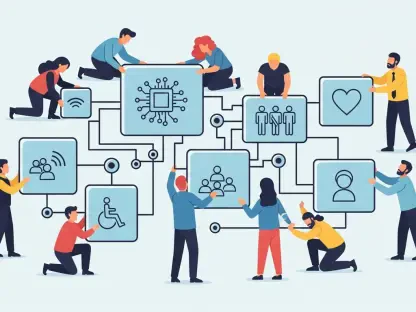Generative AI is poised to redefine the landscape of software development with its capabilities that aid and expedite the coding process. It’s a subject of both excitement and apprehension as advancements suggest that developers could see their task completion rates double with the aid of AI tools, according to a study by McKinsey. This leap in productivity stems not just from an increase in speed but also an enhancement of the quality of work generated by developers. These AI-driven tools serve as catalysts for change, retooling the very essence of coding efficiency, and bringing into focus the collaboration between human ingenuity and machine precision. Shortening the development lifecycle and ensuring better code quality, generative AI stands at the forefront of technological innovation, primed to facilitate a transformation in how software development and developer productivity are understood and measured.Traditional measures of developer productivity, like lines of code written or hours spent on a task, are increasingly being recognized as insufficient at capturing the true value delivered by software development efforts. As the world shifts toward more dynamic and agile technology ecosystems, these metrics fail to account for vital factors such as code maintainability, scalability, and overall impact on project success. The demand for more sophisticated measures is giving rise to an emphasis on outcomes over output, quality over quantity, and strategic implementation over sheer effort. Generative AI tools enter this redefined sphere of productivity measures with a promise of streamlining development processes and enhancing the ability of developers to meet these nuanced performance standards.
Redefining Developer Productivity Measures
When it comes to gauging developer productivity, the industry is moving past simplistic metrics and toward more nuanced measures that account for the intricacy and relevance of the work being done. The DORA metrics—deployment frequency, lead time for changes, change fail rate, and mean time to recovery—serve as strong indicators of a development team’s performance. By focusing on these aspects, organizations can better understand the impact of individual contributions and more accurately assess the effectiveness of their development pipeline.The article adds to this by spotlighting the use of project management tools, frameworks such as SPACE, and KPIs, all of which are paramount to monitoring developer work and ensuring continuous enhancement in the software development process. By setting clearly defined targets, these tools help to benchmark progress and facilitate goal-oriented improvements. Generative AI is set to shape this productivity landscape further by automating and refining key aspects of the coding process, thus allowing developers to focus on strategy and innovation.
The Role of Team Dynamics and Collaboration
Productivity involves more than individual output; it is deeply influenced by team interactions, the flow of information, and shared responsibilities. GitHub and similar platforms have revolutionized the way developers collaborate, enabling them to work on code collectively and respond to issues in real time. The article dives into how such collaborative tools, when utilized effectively, enhance collective efficiency, leading to better coding practices and end products.The emergence of the DevOps approach, which advocates for a seamless integration of development and operations teams, is emblematic of the shift toward more synergistic and responsive software development processes. The article provides insights into how embracing DevOps practices can substantially reduce development bottlenecks, effectively manage technical debt, and foster an environment that is conducive to high productivity levels, further underscored by the potential amplifications promised by generative AI tools.
Generative AI’s Efficiency-Boosting Capabilities
With generative AI, efficiency is not just about doing things faster—it’s about doing them smarter. The article examines the range of AI’s capabilities, from autocomplete functions that speed up coding to intelligent suggestions that refine code quality. Assistance with documentation and the provision of context-aware learning experiences also underline the multifaceted benefits that these AI tools bring to the coding table.Code translation and the automation of test cases present exciting opportunities, especially in the realm of legacy systems that require modernization. The article also explores generative AI’s application in bug detection—demonstrating how AI can lead to more resilient software and accelerate development cycles, all while supporting developers with robust tools that extend their natural capabilities.
Generative AI’s Operational Mechanics and Human Augmentation
At the core of generative AI’s efficacy lies its sophisticated machine learning models, pre-trained on vast datasets to understand and replicate the structure and syntax of programming languages. As generative AI tools learn and adapt from user interactions, they become increasingly capable of generating code that aligns closely with human developers’ intentions and standards. The article outlines a scenario wherein a developer utilizes generative AI to build a complex feature, showing how the technology accelerates the process, yet also how the developer’s expertise ensures that key project standards and testing procedures are meticulously upheld.Through this synergy of human and AI capabilities, generative AI serves as a powerful assistant that supports and amplifies human creativity and problem-solving. It helps maneuver through coding challenges and assists developers in delivering high-quality, reliable software solutions.
Introducing IBM’s WatsonX Code Assistant
The tech industry has witnessed the arrival of IBM WatsonX Code Assistant, an innovative generative AI tool designed to bolster developer and IT operator productivity. Crafted upon IBM’s advanced Granite foundation models, this tool exemplifies the potential of AI to deliver actionable, high-quality code recommendations. The article assesses its potential to streamline coding processes and concludes that while such tools improve efficiency, the human element remains irreplaceable, especially when it involves creativity and complex problem-solving in software development. As these tools evolve, they promise to offer increasingly sophisticated functionalities, potentially revolutionizing the efficiency and efficacy of software development practices.









